SsangYong Korando SUV (2011-2019)
"The SsangYong Korando gives you a lot of car for your money – but nowhere near as much as a Dacia Duster"
Pros
- Good value for money
- Spacious interior
- Low emissions
Cons
- Noisy diesel engine
- Poor-quality plastics
- Uncomfortable suspension
The SsangYong Korando is the brand’s mid-size SUV, pitched as a low-cost rival to the Nissan Qashqai, Hyundai Tucson and Kia Sportage.
Powered by a 2.2-litre diesel engine, it’s available with either two or four-wheel-drive. The engine is pretty punchy, with 175bhp, and the two-wheel-drive version can return up to 53.3mpg fuel economy. That figure isn’t quite enough to beat diesel-powered versions of the Dacia Duster and Mitsubishi ASX, though.
On the move, the Korando isn’t as stable as a lot of its rivals, either – it tends to wallow about when going around corners and has an uncomfortable ride.
All Korando models come with alloy wheels, electric windows, cruise control and Bluetooth phone connectivity. That’s a decent kit list for the price, but there are some iffy plastics inside.
MPG, running costs & CO2
In order to keep up with strict European emissions rules, the Korando received a new 2.2-litre diesel engine in Autumn 2015. This 175bhp diesel engine can return up to 53.3mpg if you go for the two-wheel-drive model. CO2 emissions are 139g/km for that car, meaning an annual road tax bill of £130.
Fuel economy isn’t quite on par with that of rivals like the Dacia Duster, Mitsubishi ASX and Hyundai Tucson, but it isn’t far behind all same. The one uncertainty is how much the Korando will be worth when you come to sell it on. Although the brand is making a big fuss about the SsangYong Tivoli crossover at the moment, it’s still pretty unfamiliar to the general public, so resale values are likely to be low. The seven-year, 150,000-mile warranty may help, however.
Engines, drive & performance
The Korando was the first car from SsangYong to use modern construction techniques. In an ideal world, that means it should be on par with almost all of its rivals in terms of driving experience. However, the suspension manages to be soft in corners – causing the car to lean alarmingly – and yet also stiff and uncomfortable over bumps.
More reviews
In-depth reviews
The 2.2-litre diesel engine also makes a tremendous racket when you accelerate, although it does speed the car up quickly enough. Light steering means the Korando is easy to drive in town. Standard electronic stability control offers reassurance, while rear parking sensors on the mid-range EX make manoeuvring easier, too.
Interior & comfort
Over bumpy roads, the Korando’s suspension doesn’t provide an especially comfortable ride, while there’s lots of body lean through corners, so passengers in the back will find they’re thrown around along twisty roads.
Interior quality isn’t the best, but at least the dashboard is well laid-out. Finding a comfortable position in the driver’s seat couldn’t be more straightforward, because the steering wheel adjusts for reach and rake, while higher-spec versions of the Korando come with leather upholstery as standard.
Practicality & boot space
Thanks to a long wheelbase, there’s lots of room for passengers and luggage inside the Korando. The rear seats recline, so it’s easy to get comfortable in the back, while the boot has 486 litres of space. That’s over 70 litres more than a Nissan Qashqai’s, but smaller than a Kia Sportage’s, although if you fold the rear seats it grows to 1,312 litres.
Reliability & safety
One of the biggest questions facing motorists considering a SsangYong is how well it’s going to stand up to daily use and what the dealer back-up will be like. The company has tried to allay any fears by supplying all of its cars with a seven-year, 150,000-mile warranty. This should cover most problems that may arise. SsangYong has more than 70 dealers around the country, so there should soon be one fairly close to you.
Price, value for money & options
All Korando models come with a decent amount of kit. The entry-level SE has air-conditioning, cruise control, electric windows and alloy wheels. In the mid-range LE trim, you’re treated to climate control, heated front seats, parking sensors, a seven-inch touchscreen infotainment system with TomTom sat-nav and a reversing camera. Next up, the ELX model has heated front and rear seats, a powered driver’s seat and 18in alloy wheels.
This sounds impressive, but the top-spec Dacia Duster Laureate Prime provides almost all of the equipment you get in the most expensive Korando ELX for only around £1,000 more than the most basic Korando. Four-wheel drive costs extra on the SsangYong, too.













